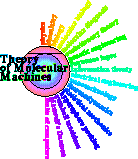 History of the
Ev
Program
History of the
Ev
Program
I had discovered that the information content of protein binding sites on DNA (Rsequence) is approximately equal to the information needed to find the sites in the genome (Rfrequency). This was my PhD thesis (Schneider1986). For several years I had been thinking that it would be useful to model that result in the computer, but my guestimates gave hundreds of years of computer time, if it was possible at all. Then I read Stephen Jay Gould's Ever Since Darwin: Reflections in Natural History, in which one essay (chapter 15, p. 126) was "Is the Cambrian Explosion a Sigmoid Fraud?". I suddenly understood his idea of punctuated equilibrium and recognized that if I used mutation, replication and selection I would get an exponential growth of organisms that have an advantage. That growth would end as they took over the population. Thus there would be a sigmoid-shaped transition, as Gould predicted. By that time I knew how to make a (weight matrix) that modeled a binding protein, so all I needed to do was work out how to embed that matrix into the genomes of organisms. Each organism in the population would have a number of binding sites. Given the size of the genome and the number of sites, one computes Rfrequency. The question was: would Rsequence approach Rfrequency during the evolution? After I finished the work on my thesis I had one week before my thesis defense. I sat down and wrote the ev program in about 2 days (this is only possible if you have a clear picture of where you are going and have disciplined methods for programming!). To my delight, in only 500 generations I could get the full evolution and Rsequence did indeed approach the predicted Rfrequency and oscillate around that level. I went into my thesis defense knowing that I could model it, but as I recall we never talked about it - this was a backup strategy!
After I came to NIH in 1987, I continued work on the program. In 1988 I had set up a large evolutionary crunch intending it to run over the weekend. I went to pick up my parents at the airport and saw a news headline saying that a worm had been attacking internet computers. This was the now-famous worm created by Robert Morris, and it had indeed gotten into our computers because one person here used their user name as their password. Curiously, the big evolution run was killed by a computer worm!
I didn't get around to publishing the Ev paper until 2000, 14 years later. What got me going was the creationists who were attacking Dawkins and claiming that it is impossible for biological systems to gain information. (See: Dawkins, R. (December, 1998) The ``Information Challenge''. The Skeptic, 18(4), 21-25 http://www.skeptics.com.au/journal/dawkins1.htm, tinyurl yr9esp) From the model, I knew that was completely wrong, and besides the model gives a nice biological result. Dawkins' self-defense was quite weak because he didn't really show how information appears and is measurable in the genome, a job that Rsequence does. The model works nicely, showing that starting from random genomic sequences and given only house keeping genes (translation, replication and general metabolism), mutation and selection generate the predicted amount of information in the binding sites. As it turned out, I could also use the model to demonstrate that three creationists (Truman, Behe and Spetner) had made serious mistakes. After the publication, in 2001, Dembski attacked my program, thinking he knew where I had "snuck in" information gain. I tested his hypothesis and found that it is wrong. Dembski had this hypothesis test and its results available to him, but he went ahead anyway and published the error in the book "No Free lunch". This case demonstrates that (so far [2000-2005]) the creationists do not admit in public to making mistakes. (See corrigenda.)
In 2004 Dembski wrote me an email admitting that his initial interpretation was wrong, but I do not yet have clear permission to publish the letter.
Stephen Jay Gould, Evolution Theorist, Dies at 60, New York Times, May 21, 2002, Carol Kaesuk Yoon.
Richard Dawkins And The 11 Second Pause What Happened During The Filming Of "From A Frog To A Prince"? Dawkins is asked: "Professor Dawkins can you give an example of an evolutionary process which can be seen to increase the information in the genome?"
Thanks to Jerry Chandler for asking "I did not know that his works influenced yours... Can you write a few sentences making this logical leap explicit?"
![]()

Schneider Lab
origin: 2002 May 22
updated: 2008 Oct 11
![]()